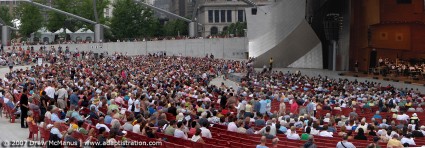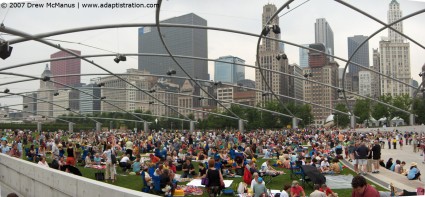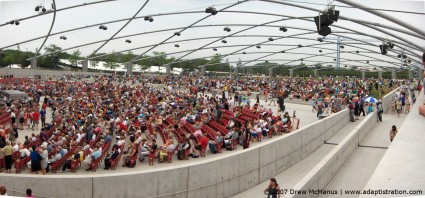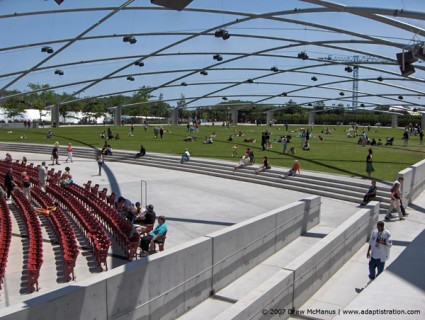It never ceases to astonish me how many managers (and even some musicians) have expressed the opinion that free concerts have little to no value. Nevertheless, when implemented properly, free concerts have the potential to do more for developing an audience and raising the level of appreciation for live orchestral music than just about any other tool available today. Case in point, the Grant Park Music Festival featuring the Grant Park Orchestra and Chorus…
Throughout the course of 10 weeks each summer, the Grant Park Music Festival attracts tens of thousands of listeners who are exposed to first rate performances. Furthermore, they cultivate and retain these listeners even though they program some of the more challenging works from traditional repertoire as well as quite a bit of new music.
At the heart of its success is the fact that the GPMF is perhaps the only large budget music festival in the country which is subsidized mostly by government funds. As a result, concerts and rehearsals are free to the public, and those concerts draw as many as 8,000 listeners.
I could go on and on but instead of pouring words all over the topic, perhaps it is better to let some pictures do the talking:
The following photographs (click to enlarge) illustrate just how popular GPMF concerts are among the Chicago public (and tourists). These photographs are of a concert from the 2006 season which featured Vine’s Percussion Symphony and Orff’s Carmina Burana. The crowds were so big that I had to take two separate panoramas, one for the fixed seats (top) and one for the lawn seats (bottom). Just in case you think everyone was there for the Orff, think again. I witnessed more people milling about or leaving during the Orff than I did during the Vine.
Not only are the concerts popular but crowds form early. The photograph below (click to enlarge) illustrates just how many listeners show up early to stake out their preferred seats. The photo was taken approximately 45 minutes before a concert (and during an evening where it was expected to rain).
Finally, orchestra rehearsals tend to draw a large number of locals and tourists every day they rehearse. It isn’t unusual to find a few hundred listeners there in the afternoon enjoying a picnic, the lunch hour, or just stopping by because they heard the music as illustrated in the picture below:
In fact, the GTMF managers noticed so many people attending rehearsals that they initiated a volunteer docent program to interact with the afternoon crowds, which is illustrated in the following photographs (click to enlarge).
The fact that Chicago stands alone among American cities to provide such an invaluable city resource – free orchestral concerts – is a shame. Of course, why would any city and/or state government find value in such an idea if the managers from their resident orchestras don’t espouse the value of free concerts on cultural enrichment?
In the end, this business needs to begin pushing for more large-scale free summer music concerts patterned after Grant Park. The politicians may kick and scream along the way but if you wait for them to do it on their own, it will never get done (and if Chicago politicians ever decide to cut GPMF funding, may God have mercy on their souls).









I love free concerts, and hope that I hear about many more. I do think that they are a great place to bring people into the Concert Hall. However, as I’ve written about, You must be careful not to think that just because a big concert like this works on the large scale, doesn’t mean it will necessarily work on the small scale. Community Orchestras, Chamber groups and Solo concerts are more likely to attract a crowd through good advertising and charging a fee, as opposed to free, or donation concerts.
My question would be: how many of the people who attend the free concerts come back and pay money for tickets. The Knight study showed that very few people who come to free concerts will pony up for the paid ones. However, that being said, there is a value to free concerts, but the problem is that funding is a major obstacle. Here in Portland we in years past did three major outdoor free concerts in various parks. We now do two because the City of Portland cut funding for one of the neighborhood parks concerts. Word from our development department is that there is little to zero draw from these concerts to the concert hall.
Hi Drew–It’s great to see another positive article about the GPMF, thanks for posting it. Just thought I’d mention that 8,000 audience members is an “average” night for us now. Recently, we’ve enjoyed performing for 11,000-12,000 listeners, and at one particular concert, I couldn’t find an empty seat by looking out from the stage. There were people standing near the wall on both sides of the seating area, all the way back to the lawn. Our rehearsals attract a lot of people who ask when the performance will be held, because they want to come back. Understandably, part of the initial draw is Millennium Park, but audiences return for the music. And you are quite accurate when describing our repertoire–it was astonishing to think that over the course of two evenings, possibly 20,000-24,000 people not only heard George Antheil’s Fifth Symphony, but also cheered enthusiastically afterward. Who knew? The only thing that I can say in conclusion is that it’s a thrill to be part of such a vital organization.
One more comment about the wonderful program at GPMF – the enormous positive face it puts on Chicago. I am always thrilled to hear visitors rave about Chicago and the wonderful free concerts that no other large city can match. They can’t wait to come back for another visit.
A few other thoughts –
* We bring our 6 year old son with us (no babysitter hassle) and he (hopefully) develops an appreciation for the music.
* The concerts (Friday) start at 6:30, which lets us get back to the western suburbs (Hinsdale) at a reasonable hour.
* We pack a picnic, so no hassle finding a restaurant and worrying about the clock before the concert.
* Seating quality is not driven by buying into a subscription series – just show up about an hour early and you can get an outstanding lawn seat.
Free is a benefit, but it’s not the only reason we’ll see many more GPMF concerts than CSO this year. Frankly, this is probably the only way for the music to live into the consciousness of the next generation.
I wanted to point out that the Houston Symphony performs two weeks of free concerts every June at Miller Outdoor Theater as well as a Dollar concert at Jones Hall every July. All events are well attended and provide the HSO with a great public face.